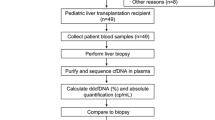Abstract
Improvement of long-term patient and graft outcome is still a challenge in liver transplantation. Personalized approaches to immunosuppressive treatment of liver transplant patients are currently under investigation, as conventional markers have limited usefulness to predict drug efficacy. The presence of graft-derived cell-free DNA (GcfDNA) in the plasma of liver transplant recipients opens up the possibility of monitoring allograft injury through measurement of this molecular marker. A rapid, cost-effective droplet digital PCR (ddPCR) method has been developed for the quantification of donor DNA. GcfDNA has shown to be useful for the detection of subclinical and full-blown acute rejection and non-rejection-related liver injury (e.g., HCV infection, liver trauma, ischemia/reperfusion damage). GcfDNA allows for the early detection of transplant injury (“liquid biopsy”) and enables earlier more effective treatment intervention. It is especially helpful to guide changes in immunosuppression and to monitor immunosuppression minimization. This new approach may contribute to achieve more effective, less toxic personalized immunosuppression.
Similar content being viewed by others
Abbreviations
- AST:
-
Aspartate aminotransferase
- cfDNA:
-
Cell-free DNA
- ddPCR:
-
Droplet digital PCR
- DNA:
-
Deoxyribonucleic acid
- GcfDNA:
-
Graft-derived cell-free DNA
- HCV:
-
Hepatitis C virus
- HELLP:
-
Hemolysis, elevated liver enzymes, low platelets
- ISD:
-
Immunosuppressive drug
- LFTs:
-
Liver function tests
- LTx:
-
Liver transplantation
- PCR:
-
Polymerase chain reaction
- TDM:
-
Therapeutic drug monitoring
- WBC:
-
White blood cells
- γ-GT:
-
γ-glutamyltransferase
References
Beck J, Bierau S, Balzer S, et al. Digital droplet PCR for rapid quantification of donor DNA in the circulation of transplant recipients as a potential universal biomarker of graft injury. Clin Chem. 2013;59:1732–41.
Beck J, Schmitz J, Kanzow P, et al. Absolute quantification of graft derived cell-free DNA (GcfDNA) early after liver transplantation (LTx) using droplet digital PCR. Clin Chem. 2014;60(Suppl):S194–5.
Beck J, Oellerich M, Schulz U, et al. Donor derived cell-free DNA is a novel universal biomarker for allograft rejection in solid organ transplantation. Transplant Proc. 2015; 47:2400–3.
Crettol S, Venetz JP, Fontana M, et al. Influence of ABCB1 genetic polymorphisms on cylcosporine intracellular concentration in transplant recipients. Pharmacogenet Genomics. 2008;18:307–15.
Falck P, Åsberg A, Guldseth H, et al. Declining intracellular T-lymphocyte concentration of cyclosporine a precedes acute rejection in kidney transplant recipients. Transplantation. 2008;85:179–84.
Gallo A, Esquivel CO. Current options for management of biliary atresia. Pediatr Transplant. 2013;17:95–8.
Gielis EM, Ledeganck KJ, De Winter BY, et al. Cell-free DNA: an upcoming biomarker in transplantation. Am J Transplant. 2015;15:2541–51.
Kanzow P, Kollmar O, Schütz E, et al. Graft-derived cell-free DNA as an early organ integrity biomarker after transplantation of a marginal HELLP syndrome donor liver. Transplantation. 2014;98:e43–5.
Lo YMD, Tein MSC, Pang CCP, et al. Presence of donor-specific DNA in plasma of kidney and liver-transplant recipients. Lancet. 1998;351:1329–30.
Londoño MC, Danger R, Giral M, et al. A need for biomarkers of operational tolerance in liver and kidney transplantation. Am J Transplant. 2012;12:1370–7.
Oellerich M, Kanzow P, Beck J, et al. Graft-derived cell-free DNA (GcfDNA) as a sensitive measure of individual graft integrity after liver transplantation. Am J Transplant. 2014a;14(Suppl3):874.
Oellerich M, Schütz E, Kanzow P, et al. Use of graft-derived cell-free DNA as an organ integrity biomarker to reexamine effective tacrolimus trough concentrations after liver transplantation. Ther Drug Monit. 2014b;36:136–40.
Oellerich M, Walson PD, Beck J, et al. Graft-derived cell-free DNA as a marker of transplant graft injury. Ther Drug Monit. 2016; 38(Suppl 1):575–9.
Organ Procurement and Transplantation Network (OPTN) and Scientific Registry of Transplant Recipients (SRTR). OPTN/SRTR 2010; annual data report. Rockville: Department of Health and Human Services, Health Resources and Services Administration, Healthcare Systems Bureau, Division of Transplantation; 2011.
Organ Procurement and Transplantation Network (OPTN) and Scientific Registry of Transplant Recipients (SRTR). OPTN/SRTR 2013: annual data report. Am J Transplant. 2015;15(Issue S2):4–13.
Pascual M, Theruvath T, Kawai T, et al. Strategies to improve long-term outcomes after renal transplantation. N Engl J Med. 2002;346:580–90.
Rodríguez-Perálvarez M, Germani G, Darius T, et al. Tacrolimus trough levels, rejection and renal impairment in liver transplantation: a systematic review and meta-analysis. Am J Transplant. 2012;12:2797–814.
Rodríguez-Perálvarez M, Germani G, Papastergiou V, et al. Early tacrolimus exposure after liver transplantation: relationship with moderate/severe acute rejection and long-term outcome. J Hepatol. 2013;58:262–70.
Sigdel TK, Vitalone MJ, Tran TQ, et al. A rapid noninvasive assay for the detection of renal transplant injury. Transplantation. 2013;96:97–101.
Snyder TM, Khush KK, Valantine HA, et al. Universal noninvasive detection of solid organ transplant rejection. Proc Natl Acad Sci U S A. 2011;108:6229–34.
Van Raemdonck D, Neyrinck A, Rega F, et al. Machine perfusion in organ transplantation: a tool for ex-vivo graft conditioning with mesenchymal stem cells? Curr Opin Org Transplant. 2013;18:24–33.
Yazigi NA. Long term outcomes after pediatric liver transplantation. Pediatr Gastroenterol Hepatol Nutr. 2013;16:207–18.
Author information
Authors and Affiliations
Corresponding author
Editor information
Editors and Affiliations
Rights and permissions
Copyright information
© 2015 Springer Science+Business Media Dordrecht
About this entry
Cite this entry
Oellerich, M. et al. (2015). Graft-Derived Cell-Free DNA as a Biomarker in Liver Transplantation. In: Preedy, V. (eds) Biomarkers in Liver Disease. Biomarkers in Disease: Methods, Discoveries and Applications. Springer, Dordrecht. https://doi.org/10.1007/978-94-007-7742-2_10-1
Download citation
DOI: https://doi.org/10.1007/978-94-007-7742-2_10-1
Received:
Accepted:
Published:
Publisher Name: Springer, Dordrecht
Online ISBN: 978-94-007-7742-2
eBook Packages: Springer Reference Biomedicine and Life SciencesReference Module Biomedical and Life Sciences




